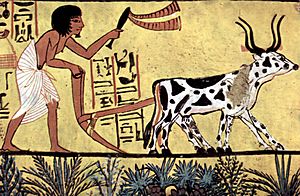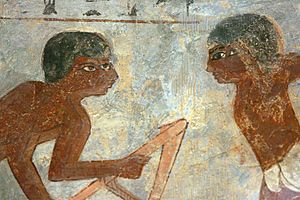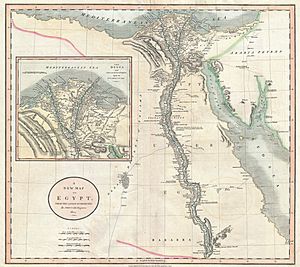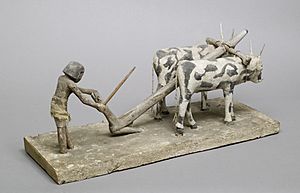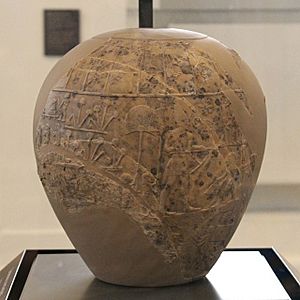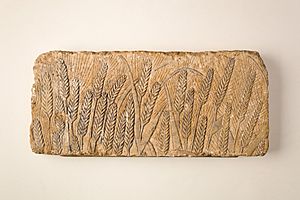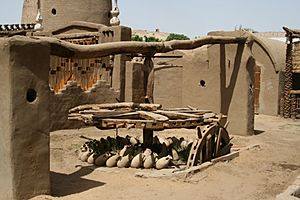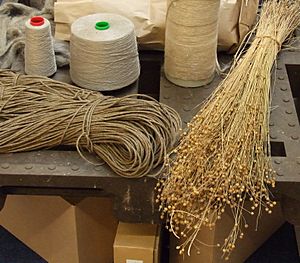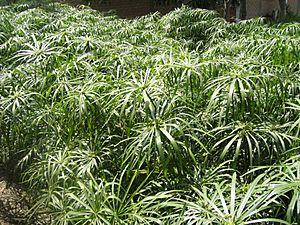Ancient Egyptian agriculture facts for kids
Ancient Egypt was a powerful civilization thanks to its amazing farming. The Nile River was super important because it flooded every year. This flooding brought rich, fertile soil, which was perfect for growing crops.
The Egyptians were among the first people to farm on a very large scale. They invented clever ways to water their fields, like "basin irrigation." This helped them grow lots of food, especially grains like wheat and barley. They also grew plants for other uses, such as flax for clothing and papyrus for paper.
Besides grains, Egyptians had many orchards and vegetable gardens. These were usually grown away from the areas that flooded each year. Farming was the main part of Egypt's economy. It provided food and jobs for everyone. It also made Egypt very rich, allowing it to be a major food supplier for the ancient world.
Contents
How did geography affect farming?
Ancient Egypt's geography was special. Unlike other places with rainy winters and dry summers, Egypt had very little rain. Most farming happened along the Nile River valley and the Nile Delta. The land needed to be watered using the Nile's floods or its normal flow.
The Nile River would start to rise in the summer and go down by late fall. This meant the main growing season was during the winter months. They called this season Sha-et, meaning "the growing season."
The second season was P' ru-et, the "dry season." This was a hot, dry time when farmers harvested their grains and stored them.
The third season, She, meant "sea." This was when the Nile flooded its banks. Each season lasted about four months.
This system usually allowed for one crop per year. A shorter farming season meant more workers were free for other big projects. These workers helped build huge temples and other royal buildings. They also worked on irrigation projects all year round. Water was often carried by hand using yokes on people's shoulders.
What were Egyptian irrigation systems like?
To use the Nile's water effectively, Egyptians created smart irrigation systems. These systems helped them control the water for many purposes, especially for farming.
They could move floodwaters away from cities and gardens to protect them. Irrigation also provided drinking water. Even though irrigation was vital, there were no big government rules for water control. Instead, local farmers managed their own irrigation.
One of the oldest signs of irrigation in Egypt is on the mace head of the Scorpion King. This carving, from around 3100 BC, shows the king digging a ditch as part of a basin irrigation system. This shows how important irrigation and farming were to their society, even for a high-ranking king.
What food crops did they grow?
Egyptians grew many different foods, including grains, vegetables, and fruits. Their main foods were cereals like barley and wheat.
Other important grains included einkorn wheat and emmer wheat, which were used to make bread. Most people also ate beans, lentils, and later, chickpeas and fava beans. They grew root vegetables like onions, garlic, and radishes. Salad plants like lettuce and parsley were also common.
Fruits often appeared in Egyptian art, showing how much effort went into growing them. Growing fruit needed more advanced farming skills, like using special irrigation, cloning, and spreading plants. The first fruits were probably native to Egypt, but more were brought in as Egypt traded with other cultures.
Grapes and watermelon were found in very old Egyptian sites. So were the sycamore fig, dom palm, and christ's thorn. Later, during the New Kingdom, carob, olive, apple, and pomegranate were introduced. Even later, in the Greco-Roman period, peaches and pears arrived.
What industrial and fiber crops did they grow?
Egyptians used plants for more than just food. They were very creative, using plants for medicine, religious practices, and making clothing.
Herbs had many uses: in cooking, medicine, cosmetics, and even for embalming bodies. Over 2000 different kinds of flowering or aromatic plants have been found in tombs.
Papyrus was a very useful plant that grew wild and was also farmed. Its roots could be eaten, but it was mainly used for other things. The stem was used to make boats, mats, and paper.
Flax was another important plant with several uses. It was mainly used to make rope and linen, which was the main material for Egyptian clothing. Henna was grown to make dye.
How did they harvest crops?
The harvest season was called Shemu. Workers called reapers cut the grain using wooden sickles with sharp flint blades. After cutting, cattle would walk over the cut grain to separate the seeds. Then, workers would toss the grain into the air so the wind could blow away the useless chaff. This was hard and slow work.
Families often hired extra workers for the harvest. Everyone helped out. Farmers would often trade their harvested crops for the things and animals they needed for the next planting season.
Ancient Egyptians used simple, handmade tools for harvesting. These included winnowing scoops, mattocks, flint-bladed sickles, and plows. The Egyptian plow had a small blade but didn't cut deep into the soil.
How did religion connect to agriculture?
Religion was a huge part of daily life in ancient Egypt. Many of their religious practices were connected to their observations of nature, the Nile, and farming. They used religion to explain things like the cyclical flooding of the Nile and how well their crops grew.
Even though the Nile directly caused good or bad harvests, Egyptians didn't worship the river itself. Instead, they thanked specific gods for good fortune. They didn't even have a name for the river, just calling it "River." The word "Nile" is not from ancient Egypt.
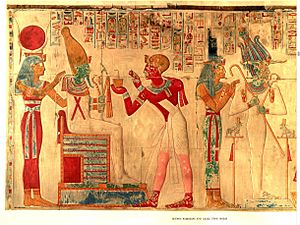
The god Hapi was created to represent the abundance of crops. He was shown as an overweight figure offering water and other plentiful goods to pharaohs. No temple was built just for Hapi, but people worshiped him with sacrifices and hymns.
The god Osiris was also strongly linked to the Nile and the land's fertility. During festivals, small mud figures of Osiris were planted with barley.
Images for kids
See also
 In Spanish: Agricultura en el Antiguo Egipto para niños
In Spanish: Agricultura en el Antiguo Egipto para niños


